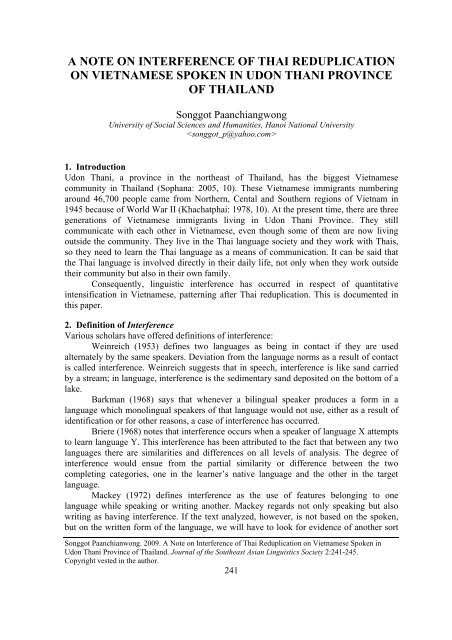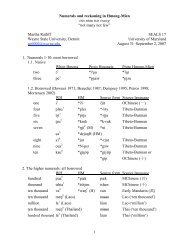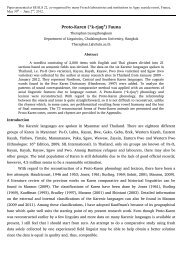proto-southwestern-tai revised: a new reconstruction - seals 22
proto-southwestern-tai revised: a new reconstruction - seals 22
proto-southwestern-tai revised: a new reconstruction - seals 22
Create successful ePaper yourself
Turn your PDF publications into a flip-book with our unique Google optimized e-Paper software.
A NOTE ON INTERFERENCE OF THAI REDUPLICATION<br />
ON VIETNAMESE SPOKEN IN UDON THANI PROVINCE<br />
OF THAILAND<br />
Songgot Paanchiangwong<br />
University of Social Sciences and Humanities, Hanoi National University<br />
<br />
1. Introduction<br />
Udon Thani, a province in the northeast of Thailand, has the biggest Vietnamese<br />
community in Thailand (Sophana: 2005, 10). These Vietnamese immigrants numbering<br />
around 46,700 people came from Northern, Cental and Southern regions of Vietnam in<br />
1945 because of World War II (Khachatphai: 1978, 10). At the present time, there are three<br />
generations of Vietnamese immigrants living in Udon Thani Province. They still<br />
communicate with each other in Vietnamese, even though some of them are now living<br />
outside the community. They live in the Thai language society and they work with Thais,<br />
so they need to learn the Thai language as a means of communication. It can be said that<br />
the Thai language is involved directly in their daily life, not only when they work outside<br />
their community but also in their own family.<br />
Consequently, linguistic interference has occurred in respect of quantitative<br />
intensification in Vietnamese, patterning after Thai reduplication. This is documented in<br />
this paper.<br />
2. Definition of Interference<br />
Various scholars have offered definitions of interference:<br />
Weinreich (1953) defines two languages as being in contact if they are used<br />
alternately by the same speakers. Deviation from the language norms as a result of contact<br />
is called interference. Weinreich suggests that in speech, interference is like sand carried<br />
by a stream; in language, interference is the sedimentary sand deposited on the bottom of a<br />
lake.<br />
Barkman (1968) says that whenever a bilingual speaker produces a form in a<br />
language which monolingual speakers of that language would not use, either as a result of<br />
identification or for other reasons, a case of interference has occurred.<br />
Briere (1968) notes that interference occurs when a speaker of language X attempts<br />
to learn language Y. This interference has been attributed to the fact that between any two<br />
languages there are similarities and differences on all levels of analysis. The degree of<br />
interference would ensue from the partial similarity or difference between the two<br />
completing categories, one in the learner’s native language and the other in the target<br />
language.<br />
Mackey (1972) defines interference as the use of features belonging to one<br />
language while speaking or writing another. Mackey regards not only speaking but also<br />
writing as having interference. If the text analyzed, however, is not based on the spoken,<br />
but on the written form of the language, we will have to look for evidence of another sort<br />
Songgot Paanchianwong. 2009. A Note on Interference of Thai Reduplication on Vietnamese Spoken in<br />
Udon Thani Province of Thailand. Journal of the Southeast Asian Linguistics Society 2:241-245.<br />
Copyright vested in the author.<br />
241





